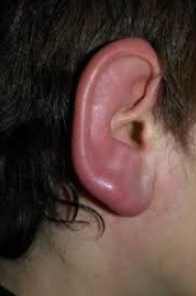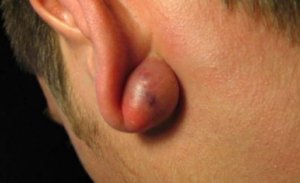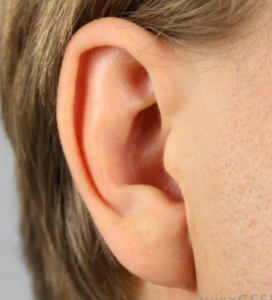Clean and Clear Continuous Control Swollen

A swollen ear lobe can cause a lot of discomforts. At times, the discomfort may extend from crusting and itching to tenderness and pain. This article is a guide of causes your ear lobe swelling, the symptom and treatment. We shall also show you how ear piercing causes this kind of swelling.
Swollen ear lobe meaning
A swollen ear lobe can be painful or not. This will depend on the underlying cause of swelling. The swelling can also be on the whole ear or on part of the ear. A swollen lobe will display tightness, enlargement and distention.

A common cause of the swelling is a condition known as swimmer's ear. The condition occurs when water gets into your outer ear canal, this can be through activities such as swimming or when you are bathing or showering. When this happens, it is often accompanied by swelling, a burning sensation inside ear and itching.
When water remains inside ear for long, it creates a warm and moist environment that encourages the growth of bacteria. Severe cases could lead to otitis externa, and an infection of the born at the base of the skull.
Ear swelling can also result from an allergic reaction to an earring. Other causes will include skin conditions such as eczema. All these ca cause your ear lobe the soft, fleshy lower part of the external ear- to swell, enlarge or disproportionally increase in size. The swelling will in most cases be accompanied by itching, a burning sensation, and pain.
A swollen ear lobe is not only caused by external factors, it could also mean something is wrong with your health. A good example is swelling caused by a drug or food allergy. The swelling, in this case, will be your immune system response to allergen-the reacting substance. For drug allergy you need to discontinue the use and report it to your doctor immediately, for food allergy, you also need to avoid consumption of such allergic foods. Seek medical attention if the symptoms persist.
Swollen ear lobe symptoms
A swollen ear lobe is in itself not an infection. It is thus a symptom of an underlying infection in or around the ear. Although most ear infection can resolve on their own within a week or two without any medical attention, it is recommended you seek medical attention to avoid complications which can include loss of hearing ability.
The swelling can be a sign of an infection behind the ear or anaphylaxis which is a life threatening allergic reaction. Seek immediate medical attention if you notice the following symptoms:
- Swelling of the throat
- Difficulties in breathing
- Tenderness behind ear especially on bone
- The ear lobe may feel lumpy or bumpy
- High fever
- Severe and persistent headaches
- Flaking, crusting, warmth and tenderness
- Redness and swelling around or inside ear
- Itchy rash around ear
A medical doctor will diagnose these symptoms and prescribe the best treatment to relieve them while treating the underlying cause of the symptoms. Depending on the underlying cause, the duration the symptoms are felt will vary, some people may also have the symptoms for long compared to others.
Swollen ear lobe causes
The causes of a swollen ear lobe can include both internal and external. Internal causes will include those causes that arise from complication from inside your body, external causes, on the other hand, will include those that are external to the ear. They can include ear piercing, contact dermatitis, poor hygiene, and bug bites.
Below are some of the possible cause of a swollen ear lobe.
Swollen earlobe cyst
A cyst is a common cause of earlobe swelling. The cyst is sac-like closed bumps filled with liquid and semi liquid materials. The cyst is much like blisters and can be painful or painless. They can occur anywhere on your body and are found in the tissues.
Cyst formed due to chronic inflammatory problems, blocked ducts, Brocken blood vessels, cell defects and other infections. The cyst can be painful especially when infected. This is usually with bacteria. To treat this kind of swelling, oral or topical antibiotics may be used.
Earlobe infection
An infected earlobe can also be the cause of the swelling. To tell an infected ear, you will have to look at symptoms such as tenderness on the pierced side of the ear lobe, swelling around or inside the ear, bleeding or yellow discharge from the ear, fever especially in children and a burning or itching sensation.
Seek immediate medical attention if you notice any of the symptoms described above.
Ear piercing
Ear piercing is one of the most common cosmetic procedure done my both female and males nowadays. When not done in the right way or by the right person, ear piercing could lead to a bacterial or another form of infection.
The pierced hole on ear lobe could become crusty or start oozing or discharge pus. It could also become painful and irritating. This is the signs of an infection. The infection could cause swollen nodes behind an ear.
Trauma and injuries on ear lobe
Physical trauma and injuries on ear lobe can also result in them solving. When no damage is done on the ear, then a warm compress twice a day can help offer relief for the swelling and inflammation.
Insect bites
Mosquito and other insect's bites can also be the cause for earlobe swelling. Stings and bites from insect are common and will often result in redness and swelling in the injured area.
Drug and food allergy
Drug or food allergy is an immune system reaction that occurs soon after eating a certain food or taking a particular medicine (mostly Amoxil). The allergen will trigger symptoms such as digestive problems, hives, and swelling.
Antihistamine medication is used to reverse such reactions. Avoiding the reacting food or drug is the best way to prevent such reactions.
Otitis externa
Otitis externa is the inflammation of the presage of the outer ear. Other types of this inflammation are otitis media, the inflammation of middle ear and otitis interna the inflammation of the inner ear. This inflammation is likely to cause your ear lobe to swell when left unchecked.
Swimmer's ear
Caused by excess water exposure, this occurs when water fills the ear, this creates a conducive environment (moist and warm) for bacterial growth. When left unchecked it could result in serious ear infections.
Cholesteatoma
This is an abnormal, noncancerous skin growth that can develop in the middle section of your ear. It could be a birth defect but it is most commonly caused by repeated middle ear infections. In most cases, it will develop as a cyst.
Mastoiditis
This is the inflammation of the mastoid process. It occurs when suppurative infection extends d=from a middle ear affected by otitis media to the mastoid air cells. The infective process causes the inflammation of the mastoid and surrounding tissue and may lead to bony destruction.
Swollen gland under ear lobe
Lymph nodes or glands often swells in one location when a problem such as an injury, infection or tumor develops in or near the lymph nodes [WebMD]. During a medical diagnosis, which glands are swollen can help identify the problem. The glands under ear lobe, neck, under jaws or behind the ear will in most cases swell when you have cold or sore throats.
Lymph glands are a very important part of the immune system. They are located through the body. Most of the time, these nodes are only visible or palpable when enlarged or swollen. The node are regional, each group of them corresponds to a particular region of the body and when swollen, they will reflect an abnormality in that particular region.
Infections are the most common cause of these swelling. Apart from infection, the other causes of the swelling are inflammation and cancer. Under ear lobe, the swelling will in most cases be caused by an ear infection. Lymphoma and leukemia, are types of cancer that can cause this kind of swelling.
The swollen node will be accompanied by symptoms such as pain, fever, and fatigue. No treatment is required for a swollen node when the underlying cause of the swelling is resolved, the swollen nodes will slowly regain their shape.
Red Swollen ear lobe in child
What causes red ear in children? A red swollen ear in children can cause lots of distress, pain, and discomfort. This can be a sign of infection, you need to have a pediatrician check it out as soon as possible. Swollen ear might be caused by an inflammation which occurs while trying to fight off infections or foreign substance.
Ear infections are common in small children. Research shows that the most common of these infections is otitis media which is a middle ear infection and otitis externa the out ear infection. This infection is prevalent in children than in adults or teenagers.
If you child has the following symptoms accompany the swollen ear lobe, you need to see you doctor immediate, it could be any of the ear infection described above.
- A thick yellow discharge from the ear (pus)
- A cold accompanied with running nose and sore throat
- High fever
- The ear may be painful t touch or move
- The child might complain of fullness in ear
- Red and swollen ear or ear lobe
- Fever or redness spread beyond the ear
Swollen ear lobe pictures
We have provided images for visual guidance below and throughout this article. The swelling may, however, vary from person to person depending on what the underlying cause of the swelling is. Please, not that, the images are for illustration purpose and as such, they do not offer a conclusive diagnosis of what might be causing the ear lobe to swell.


Swollen ear lobe with lump
A small lump or bump accompanying a swollen ear lobe is most likely to be an abscess or a pimple. A cyst or a pimple can be a non-cancerous lump that often arises beneath the skin. A sebaceous cyst or epidermoid cyst is one of these lumps. This lumps are painless and do not pose any health risk. These lumps, therefore, warrant no medical attention. If the lump becomes painful, infected or bothersome, you have the option of having it removed by your dermatologist through a cosmetic surgery.
The lump occurs when cells move deeper into the skin, they increase in number rather than sloughing off. The cell will produce keratin that drains into the cyst behind your ear.
Itchy swollen ear lobe
Itchy or the constant urge to scratch can be unbearable especially for children. Mild itchy can be relieved using over the counter topical anti-itching or anti-inflammatory creams. For severe cases of itching, you need to seek medical attention.
The cause of itching can range from a simple skin irritation, contact dermatitis to a serious condition like an allergy or an autoimmune disorder where your body immune become overactive thus start to react with healthy body cells.
Understanding the cause of the itching can help in treating and getting rid of this sensation.
Swollen ear lobe after piercing
Ear piercing is the practice of making holes in the lobes or ridges of the ears s that you are able to wear earrings. Jason S Hamilton MD, the director of plastic and reconstructive surgery for the Osborne Head and neck Institute, agrees that body piercing has become more popular and less taboo in the recent years.
With increased piercing, there has been a constant increase in complication, the human ear is one of the most common parts for these complications. The ear is prone to injuries and infections. The human ear is composed of a mainly cartilaginous framework. A cartilage is a strong and very flexible material that provide support as well as flexibility.
Blood vessels are not present nerves are not present within the cartilage tissues. Infection or damage on your ear lobe can thus cause you ear lobe to swell and become very painful. It is important to have a professional do the piecing to avoid such complications.
The tools used should be clean, avoid sharing such tools and make sure you apply spirit or hydrogen peroxide on the resulting wound after piercing. If the wound starts to swell or fails to heal within a week, seek immediate medical attention.
Swollen ear lobe and lymph nodes
As discussed above, lymph node is regional and distributed all through the body. The lymph nodes or gland behind the ear will swell due to an infection, injury or tumor inside or around your ear. No medical intervention is required for swollen nodes.
If however, the ear infection causing the swelling has been treated and the nodes are still swollen, then this can be a sign of another underlying medical condition. Seek medical diagnosis so that the condition can also be treated.
Swollen Ear lobe Treatment
Treating a swollen ear lobe depends on the underlying cause. For an instant, mild or severe cases of bacterial infection can be treated with a topical or oral antibiotic. Antiviral medication will be used in cases of viral infection of the ear.

For inflammation and severe case of swelling, a corticosteroid injection can be used. Topical ointment can offer relief for irritation and itching. Ear drops will help with stuffy ear and other condition such as otitis externa.
If the cause of the swelling is food or drug allergy, the antihistamine medication can be used to treat the swelling. Deep bumps and cyst accompanying the swelling can be treated by draining or removing them by surgery.
Other treatment option are discussed above under different causes.
How to get rid of swollen ear lobe with Home remedies
For mild cases of the swollen ear lobe, the symptoms can be managed and relieve at home. Below are some of the home remedies you could use to reduce the swelling and relieve the ear lobe of other symptoms such as itching, pain, and inflammation.
A mixture of honey and black tea
Raw organic honey has different properties that can offer relief for swollen nodes. Honey also contains anti-inflammatory that can help ease pain and swelling. When mixed with tea, it can help fight bacterial infection due to its rich antibacterial properties.
- In a cup of tea or your favorite drink, add a teaspoon of honey
- Gently stir the solution to mix
- Drink the tea when hot
- Repeat this twice daily for a week for optimal result
Warm compress
For sebaceous cyst, boil, and abscess, a gentle warm compress can be an effective way to offer relief for the swelling, inflammation, and pain. The process should be done gently to avoid popping the cyst.
Rinsing with salt water
Compressing swollen lymph nodes can help shrink them and get them back to their normal size. Add a tablespoon of kitchen salt in some water, gently mix and using a clean face towel compress the swollen nodes behind ear.
Tea tree oil
Dilute tea tree oil contains a component that is able to reduce inflammation and swelling associated with different ear condition most specifically hypersensitive reaction. The remedy is also used to fight off skin infection caused by fungus and bacterial infection. The oil is also good for allergic skin reactions.
Before using this oil on skin, make sure you dilute the oil to avoid hush skin reaction and other potential health problems.
Turmeric paste
Turmeric is another commonly used remedy for skin problems. It contains anti-inflammatory properties due to an active component called curcumin. It is also rich in vitamin C, iron, potassium, zinc and calcium which help nourish the skin.
Aloe Vera gel
The anti-inflammatory and anti-bacterial properties of aloe Vera makes it an effective natural occurring remedy for pain, inflammation and for fighting the bacterial infection that might be causing your ear lobe to swell.
Sources and references:
- Swollen ear lobe causes
- Symptoms of swollen ear lobe
- What causes ear lobe to swell?
- Treatment for swollen lobes
- Treating swollen ear lobes
- Ear piercing infection bump

Source: https://www.howtocurefast.org/ear/swollen-ear-lobe-causes-symptoms-treatment/